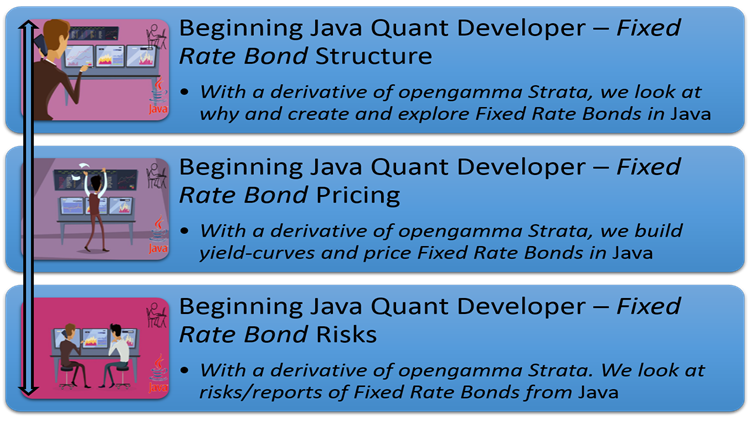Beginning Java Quant Developer – Fixed Rate Bond
Filed under: Bonds, Capital Markets, Development, Java, JVM, Quant Development
Comments: None

Quant Developer, we look at constructing, pricing and reporting on Fixed Rate Bond securities in Java using opengamma strata.
We, at poc-d, have taken opengamma‘s strata library (which has been developed in java) and extended it for online learning of capital market products for C#, VB.Net, C++, Python, Java and Scala developers as well an Microsoft Excel addin for financial analysts.
The learning is hands on, which means you will be provided a copy of the library to follow along.
Course Curriculum
- Module #1 : Fixed Rate Bond Structure
- xxx
- xxx
- xxx
- Module #2 : Fixed Rate Bond Pricing
- xxx
- xxx
- xxx
- Module #3 : Fixed Rate Bond Risks
- xxx
- xxx
- xxx
- Provided (for hands on)
- Microsoft Excel Addin which exposes required opengamma strata financial functions within Excel
- Opengamma jars in which to write capital market code against (for Scala or Java)
- Required
- Minimum Microsoft Windows 7
- 4GB of RAM (8GB preferred)
- ScalaIDE for Scala or Java Development. Eclipse (or any other Java IDE) for Java Development
- Optional : Microsoft Excel 2007 onwards
Course Access
This course is broken down into modules (as seen in the graphic above).
You can access all the Capital Market courses based on C#, VB.Net, C++, Python, Java, Scala and Microsoft Excel for one low monthly fee. Currently the membership site houses courses that covers Fixed Rate Bonds, Swaps, Inverse Floaters, Swaptions and Cap/Floors.
- POC-d membership site : POC-D Membership site
Or each module can be purchased individually from
- Udemy : POC-D Udemy Individual modules
Fixed Rate Bond Securities
In finance, a fixed rate bond is a type of debt instrument bond with a fixed coupon (interest) rate, as opposed to a floating rate note. A fixed rate bond is a long term debt paper that carries a predetermined interest rate. The interest rate is known as coupon rate and interest is payable at specified dates before bond maturity. The fixed-rate bond, although a conservative investment, is highly susceptible to a loss in value due to inflation. The fixed-rate bond’s long maturity schedule and predetermined coupon rate offers an investor a solidified return, while leaving the individual exposed to a rise in the consumer price index and overall decrease in their purchasing power.
The coupon rate attached to the fixed-rate bond is payable at specified dates before the bond reaches maturity; the coupon rate and the fixed-payments are delivered periodically to the investor at a percentage rate of the bond’s face value. Due to a fixed-rate bond’s lengthy maturity date, these payments are typically small and are not tied into interest rates.
Purchasing a fixed rate bond is knowing, from the very start, what to expect out of the investment. As such, beginners in the investment world, as well as more experienced but conservative ones see this as a good and stable option. Those who are not very well-versed in investments could benefit, because it would no longer becomes necessary to monitor each change in the economy that might have a detrimental effect to the expected return of the bond.
Regardless of how the official Bank interest rate moves over the term of the bond its interest rate stays fixed until the bond expires.
The text below is an edited version taken from the strata web site : http://strata.opengamma.io/introduction/
Introduction to Strata for the Quant Developer
What is Strata?
Strata is the award-winning open source analytics and market risk library from OpenGamma.
Strata allows quant developers to build or enhance existing applications with standardized, off-the-shelf market risk components. It includes:
- Pricing, financial analytics and curve calibration
- Reporting
- Scenario evaluation
- Trade modelling
- Market data representation
- Financial foundations – currencies, indices, holidays, date adjustments, schedules, time-series
Strata has been built from the ground up to be lightweight and flexible. It does not impose any database, server or middleware requirements; these would be built on top of Strata. It provides a high-quality, open source Java toolkit that is designed to be used both in its entirety, as well as for its individual components.
Who is Strata for?
Firms have long employed expensive resources – quants and quant developers – to build and maintain market risk functionality that offers no real competitive advantage. Where possible, they wish to leverage existing investments in systems and other in-house technologies, while looking externally for just the components required to fill their solution gaps.
Is there an alternative?
One alternative to building in-house is to look towards out-of-the-box offerings provided by financial software vendors. While these vendors offer solutions to industry business issues, the downside is that many firms have been burned by opaque, closed source vendor models, including vendor lock-in to make or support any changes, and “sledgehammer to crack a nut” software footprints.
Solution
Strata delivers the best of both worlds – industry standard market risk functionality, distributed as open source java software to eliminate vendor dependency and return control back to in-house development teams. With open access to standard market risk components and java source code, firms can accelerate the time-to-market of their solutions.
Developers
Strata is aimed at quant or systems developers tasked with delivering analytic solutions into trading, risk, clearing or prime servicing, or collateral businesses. Strata empowers developers with vetted open source java components that deliver standard market risk functionality, allowing them to focus on the unique aspects of solutions delivery to their business stakeholders.








